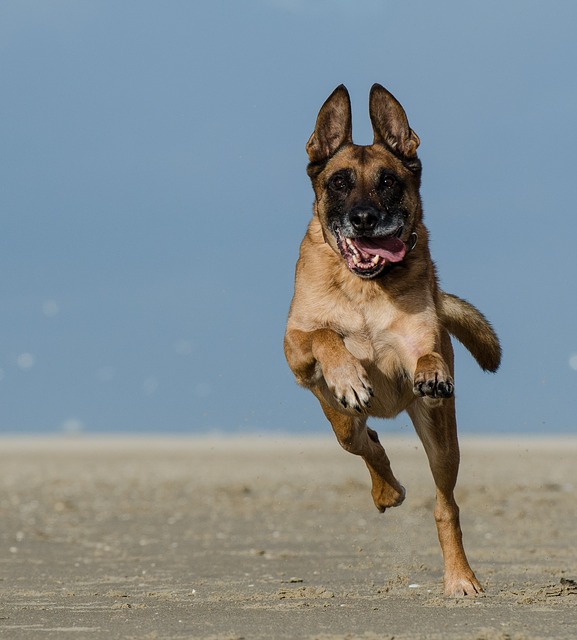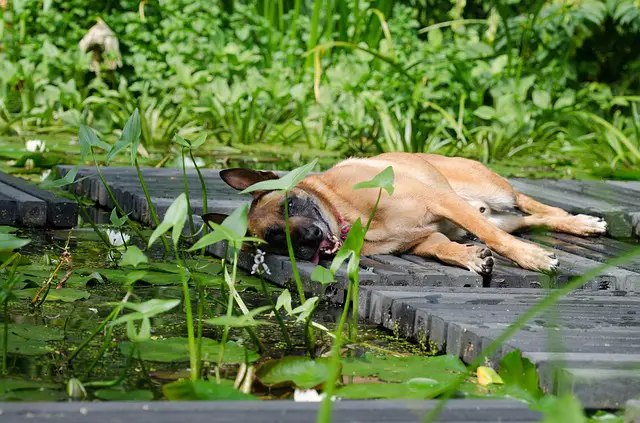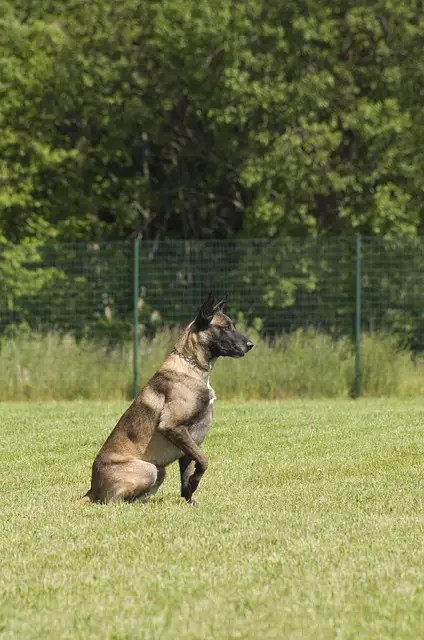The Belgian Malinois is a highly intelligent breed often used by law enforcement officers and in the military.
The German shepherd has generally been used with police as their loyal and courageous furry partners, but the Belgian Malinois’s excellent skills and abilities for guarding have surpassed the popularity of the German shepherds with more demand now, for the Malinois.
These two dogs are similar-looking and often confused and share the need to be healthy to perform their very important duties.
The Belgian Malinois is not normally predisposed to health issues, but some can suffer from health conditions with a few being more common than others.
Health conditions or diseases can be hereditary, which means passed down by the parents or they can be due to environmental triggers, such as exposure to a toxin or even inadequate nutrition. Just as in humans, dogs can develop diseases and there is no rhyme or reason.
The Belgian has an average life expectancy between ten and fifteen years and if they are well taken care of and do not acquire any conditions, the upper end of this range is possible.
In this post, there will be information on potential health problems including Belgian Malinois hip dysplasia, cataracts, and epilepsy.
Included will be signs, symptoms, and treatments so you can be informed if you have a Belgian Malinois or are contemplating getting one.

For your dog’s vitamin supplement, food, toys, or other dogs product please visit the Sundays for dogs website.
Belgian Malinois Health Problems
The Belgian Malinois can suffer from a few health problems, but this does not mean that yours will develop any at all. Listed below are some conditions and symptoms to recognize.
Belgian Malinois hip dysplasia
Their femur bone will not be in proper alignment with the pelvic bone, and this creates the hip joint, which will be abnormal and defective. This may occur due to trauma, or an out-of-the-ordinary change in bone development.
Most often this is genetic in nature and due to this misalignment, your pup develops osteoarthritis, which causes pain.
Breeds more prone to hip dysplasia are generally larger-boned breeds such as the German shepherd, Golden retriever, Labrador retrievers, Great Danes, St. Bernard’s, mastiffs, Bernese Mountain Dogs, and yes, the Belgian Malinois.
These are mostly larger and giant breed dogs, but oddly, the Corgi and the bulldog have a genetic predisposition to hip dysplasia with their short legs and larger body, adding extra weight on small bones to exacerbate this problem.
To check your Belgian Malinois health status or their DNA, please visit the Embark vet website for all the help you may need

Symptoms of hip dysplasia are:
- Difficulty with sitting and climbing stairs
- Obvious stiffness in the back legs and especially the hip area
- Less active
- No interest or excitement for exercise or play
- Fatigue and lethargy
- Limping
You can’t prevent hip dysplasia if it is inherited, but before adding one to your family, use a reputable breeder, who performs testing for hip dysplasia. Breeding dogs suffering from hip dysplasia should not be bred.
Pain medications and anti-inflammatories are often used. If you already own a Belgian Malinois, be observant of any signs and symptoms if anything is unusual.to read more visit this link
Veterinarians usually screen for this as puppies with x=rays. Also, make sure your pup receives a healthy and nutritious diet and plenty of exercises right from the start.
An overfed dog that is sedentary will lead to an obese dog with weight putting added stress on joints, not to mention the development of other diseases.
Belgian Malinois elbow dysplasia
Elbow dysplasia is made up of one of three different conditions, osteochondritis dissecans, un-united anconeal process, and the most common, fragmented coronoid process.
Usually, elbow dysplasia manifests in young, still-growing dogs and most often in larger breeds. It is usually caused again, by genetics, but can be environmental in nature caused by excess weight, inadequate diet, and improper nutrition.
Symptoms of elbow dysplasia are:
- Stiffness upon rising
- Discomfort and limping after playing and exercise
- Reluctance to play and exercise
- Joints are swollen
If you notice symptoms your veterinarian will examine your pup and if this is suspected, x-rays will be taken.
If elbow dysplasia is confirmed, surgery is the treatment of choice to remove cartilage or bone fragments as well as perform bone realignment.
After surgery, control their diet and keep them comfortable. Surgery may have to be repeated and they may have a decreased lifespan due to later immobility.

Belgian Malinois Epilepsy
Epilepsy is another potential hereditary condition depending upon the root cause and it does plague the Belgian Malinois breed.
Symptoms generally occur between the ages of two and five and can be frightening for owners.
It is caused when your Belgian’s brain begins discharging many neutrons at one time which results in a seizure or convulsion. Often, no medical condition can be found for the occurring seizures.
Found in dogs, there are three types of seizures: primary, reactive, and secondary. The primary seizure is diagnosed when no known cause can be identified. It is generally inherited and referred to as idiopathic epilepsy.
Reactive seizures are a result of a problem that is metabolic in nature, like ingesting a toxin or low or high blood sugar, which causes the brain to react in this way.
A secondary seizure is caused when your pup suffers from trauma, has a stroke, or has a brain tumor. There are three stages to a seizure listed below with symptoms of each.
Aura Seizure in Belgian Malinois
The signs preceding a seizure Aura Seizure
- Hiding
- Affection-seeking (more than usual)
- Seems disoriented or lost
- Whines
- Drools excessively
- Very restless
- Shakes or trembles
Ictus – seizure
Ictus – seizure begins and this stage can be very short or last minutes
- Falls over and kicks or shakes legs
- Body trembles
- Drools
- May lose control of bladder or bowels
Postictal – seizure
postictal – seizure is over and unfortunately, this stage may last days or end quickly.
- Confusion
- Disoriented
- May seek comfort
If your Belgian Malinois should have a seizure, try to stay calm and keep in mind that they are unaware of this event and are in no pain.
Remove anything around them that they could injure themselves on furniture, etc. Stay with them for comfort and just observe so you can describe this to your veterinarian.
This information is extremely valuable and may determine the cause. Contrary to what you may have heard of seizures, a dog or anyone will not swallow their tongue during a seizure.
If your dog’s seizure lasts more than five minutes you need to get them to a veterinary hospital for treatment.
Although it may seem long, seizures generally may be only seconds or a minute. They still do need to see their veterinarian even after a short seizure.
Depending on the diagnosis of the seizure, idiopathic epilepsy would be treated with medication, usually phenobarbital, most often for life. With a reactive seizure, controlling your pup’s blood sugar would eliminate convulsions.
If, however, the seizure is secondary, discuss with your veterinarian the best course of action if it is due to a brain tumor, stroke, or trauma.

Cataracts in Belgian Malinois
Humans and dogs alike can suffer from cataracts, especially as they age. Cataracts form when eye proteins cluster together and continue to do so until the lens is clouded.
Your pup’s eye will not only be cloudy and milky looking but their vision will also look this way. This can lead to blindness if not treated.
Cataracts are inherited, but also can be caused by diabetes. If your Belgian Malinois is aging and you notice a film over one or both eyes and they seem to be bumping into furniture, have your veterinarian check their eyes.
They may also show signs of light sensitivity and watery eyes. Cataracts can grow slowly or quickly. Surgery is the best treatment for cataracts.
Certain diseases that can occur in your Belgian Malinois are not always preventable especially if they are hereditary in nature.
You can prevent some and keep existing conditions from worsening. From the start as a puppy, ensure that they are getting high-quality nutrition, plenty of exercises,s and seeing their veterinarian for wellness visits and necessary vaccinations.
These are all key factors in helping your Belgian Malinois to have a wonderful, happy and healthy life.